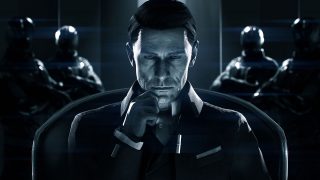THE HISTORY OF CASCADIA
Today, the Conglomerate rules the nation of Cascadia. But long before the corporations took their shared place on the throne, a nation called OmniStat once rose from the Regression, the Civil War divided OmniStat into three parts, of which Cascadia was one, and the November Riots propelled the Conglomerate to power.
It’s safe to say that Cascadia holds a lot of history, and in this post you’ll get to read all about the pivotal events that shaped the entire nation and the city you’ll experience in Mirror’s Edge™ Catalyst.

The Rise of OmniStat
The Rise of OmniStat
Out of the Regression rose OmniStat. Inspired by tales of ancient utopias and classless societies where every citizen had equal value and production was owned and shared by all, OmniStat quickly swallowed up the majority of the isolated settlements and surviving cities – sometimes peacefully, sometimes not. Some refused to acknowledge the OmniStat way of life and resisted to the bitter end, causing much strife and paranoia within OmniStat itself as the rulers were forced to accept that not everybody was ready to blindly embrace their vaunted ideas of the perfect state.
They reacted with increased control, to the point that all citizens were surveyed by the authorities, and each other, all the time. OmniStat soon became a merciless tyranny perpetuated by The Party and its ruling elite in their fevered struggle to centralize and control everything and everyone.

The Kruger Uprising
The Kruger Uprising
One of the ancient clans, the Kruger family, accepted OmniStat rule but made sure to secure important positions within the Party as it grew. However, they never truly accepted the Party line and the philosophy it was founded on, and as the decades passed they began plotting drastic change – believing that for civilization to truly move forward a radically different society had to be formed, one based on free enterprise and individual achievement.
Always wary of betrayal, the Krugers still managed to gather a few other powerful families to their cause – some were prominent party members, and others held important industrial positions. When the flames of rebellion and civil war finally engulfed OmniStat, the Kruger family and their allies were at the forefront of the struggle.

The Civil War
The Civil War
Decades of accumulated hate and frustration helped turn the flames into a devastating conflagration and soon OmniStat was torn apart in a bitter civil war. The fighting lasted for years and the leading families were forced to acknowledge that theirs was not the only vision of an ideal society. There were others who also saw these turbulent times as an opportunity to set up their own societies, and when the dust eventually settled three nations formed from the ashes of what was once the most powerful civilization on the planet.
OmniStat Divided
As the war ended, the OmniStat rulers grudgingly acknowledged that much of their once vast nation remained only in the historical records. A peace conference was called, attended by the leaders of the three main factions that had formed during the war.
It was agreed that OmniStat would be split in three: The largest part would still be OmniStat and remain under Party rule; the second largest was to become Cascadia – shaped by the families supporting the initial Kruger Uprising; finally there was Sabaeus, a secretive and secluded nation founded on a strict religious faith and ruled by clerics.
A fragile and tentative cease-fire was agreed upon and borders drawn up. Tensions remain high to this day though, and many claims and counterclaims were never properly satisfied. Few believed in a lasting peace.

The Founding
The Founding
The original vision of Cascadia was a nation founded on democratic principles, where individuality and initiative was to be encouraged and rewarded. However, Cascadia’s founding was off to a flawed start, as the families involved in the uprising had less altruistic intentions. The democratic principles were only vaguely converted into actual law and the nation grew on an insecure foundation as the system favored those who had already secured vast assets during the chaotic war. With voting rights curtailed from the outset, and with several of the old families not ready to share their accumulated power, the first steps down the road to tyranny had already been taken.

Rise of the Corporate Houses
Rise of the Corporate Houses
A deep fear and hatred of OmniStat and the Party drove a nation-wide initiative to eradicate the old and rebuild anew. Statues were built, honoring values such as freedom and initiative, as well as the Original Twelve – the heads of the families that had supported the Kruger Uprising.
Within a decade those same families controlled almost 80% of the “free” market, and their dominance kept growing. Oligarchies between them formed and fell apart, and all the while the Cascadian Assembly struggled to create laws that would limit corporate control. But with most Assemblymen belonging to one of the families the laws remained toothless.
The families became known as the Corporate Houses and their opulence and wealth knew no bounds. Cascadian society eventually stratified into three distinct castes: the loCaste eking out a meager existence in the Greylands, the midCaste trapped in an eternal rat-race in the growing cities, and the hiCaste enjoying a detached existence at the top of the pyramid.
Learn more about the Corporations in Glass
The Conglomerate
The Conglomerate was born when the twelve major Corporate Houses joined together with the intent of mutually shaping the future of Cascadia. Their internal rivalry remained to some extent though, and it was decided that only nine would sit on the Conglomerate Board at any one time, depending on their respective market shares. This was intended to still foster some competition between them and make sure they didn't stagnate completely.
The formation did not go unopposed. For years the discontent had grown among the general populace to the point that open protests were held against the worsening work environments, declining social conditions and rapidly increasing corporate encroachment on the elected government. The issue was debated for months on end in the Cascadian Assembly, but only toothless statements ever came out of the discussions.

The November Riots
The November Riots
As the Conglomerate grew in power tensions grew with it, and different protest movements came and went until one of them, based on pacifistic ideals, took root and spread quickly. It found its strongest supporters in Glass where it had also been founded, and on a cold November day, a hundred thousand demonstrators marched on Zephyr Station. There they gathered to listen to speeches and protester songs. But something went terribly wrong and some protesters began acting violently. Shots were fired and within moments the peaceful gathering had turned into a rioting stampede. For three days the riots raged unabated and Glass burned.
In the end the authorities prevailed, the riots were culled and those responsible (who still lived) were rounded up. The original leaders were found brutally executed, and the deed was blamed on the same separatist hardliners who supposedly started the riots to begin with. The Conglomerate saw its chance to grow stronger and made sure to point to the weak Assembly and their ineptness in handling the situation.

The Conglomerate Takes Power
The Conglomerate Takes Power
The measures taken by the elected Assembly to rectify the situation proved to be too little too late, and when the Conglomerate declared the Assembly unfit to rule the nation, few opposed the move. The Conglomerate came to rule Cascadia, and Glass became a symbol of Conglomerate greatness. The refurbishing of the entire city was accelerated and immense resources spent on making Glass a pristine bastion of Conglomerate power, trumped only by Cascadia Prime, the Capital, where the Conglomerate Board resides.
15 years after the Conglomerate has taken power, Mirror’s Edge Catalyst puts you in the shoes of Faith, the heroine who will fight for those who can’t in the ongoing struggle against Conglomerate control. You will claim your freedom and fight the oppression that has hovered over the city far too long.
Learn more about the world of Mirror’s Edge Catalyst on the Story Page

